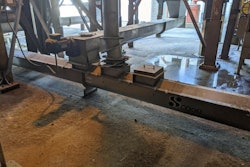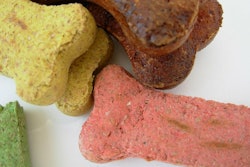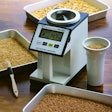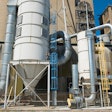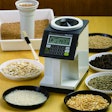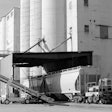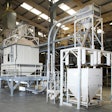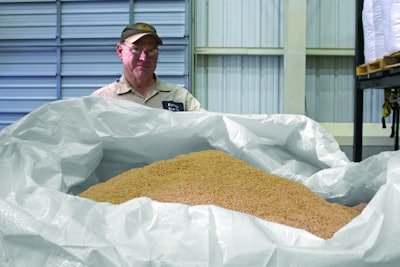
According to the U.S. Department of Agriculture (USDA), the 2020 U.S. rice harvest totaled 11.6 million metric tons. The majority of this crop comes from six states – Arkansas, California, Louisiana, Mississippi, Missouri and Texas – with about 24% from Louisiana alone.
Because the Louisiana harvest takes place primarily over two months, it places a huge demand on the area’s processing capacity. Any delay in moving the processed rice to market can result in severe cash flow problems for growers.
To deal with this peak demand, Kennedy Rice, one of the largest growers in Louisiana, constructed a new rice processing facility to convert freshly harvested and dried grain, known as rough rice, into polished white rice ready for sale to customers.
Opened in 2012 with the capacity to process up to 136,000 metric tons of rough rice/year, the facility took about two years to build and cost over $10 million.
The Kennedy Rice mill fills orders as they are received rather than stockpiling polished white rice in a warehouse. Ninety-five percent of the finished product is shipped in bulk by rail or barge, but a growing amount of it is packaged in 2,000-pound bulk bags which the company fills using a Twin-Centerpost™ bulk bag filler from Flexicon Corp.
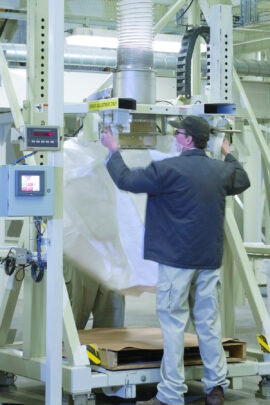
Bulk bags filled in response to orders
“We usually try to complete bulk bag orders two to three days in advance," says Marley Oldham, plant manager. "The bulk bag filler is located in the warehouse, so filled bags do not need to be moved until they are ready to be shipped,”
“Since we only recently began offering polished white rice in bulk bags, they account for a small percentage of our total production,” explains Oldham. “We expect demand to increase significantly, however, and our bulk bag filler is designed to meet our future requirements.”
The polished white rice to be packaged in bulk bags is aspirated to remove dust particles before being fed into an 80-inch-high, 82-cubic-foot capacity hopper mounted above the bulk bag filler. The rice flows from the hopper through a dome valve and 10-inch-diameter flexible downspouting into the bulk bag suspended above the deck of the Twin-Centerpost™ Bulk Bag Filler.
Bulk bag filler designed for automatic operation
Plant air inflates the 50-inch-high bag for filling while an inflatable collar on the fill head holds and seals the bag spout. A filtered air vent at the fill head assures dust-free delivery of material to the bulk bag while providing a simple way to allow displaced air to exit the bag.
Except for manually connecting the bag spout to the inflatable collar, the process is automated by a programmable logic controller (PLC). Load cells beneath the pallet deck send signals to the PLC, which automatically stops the flow of rice by closing the dome valve when the bag reaches its target weight.
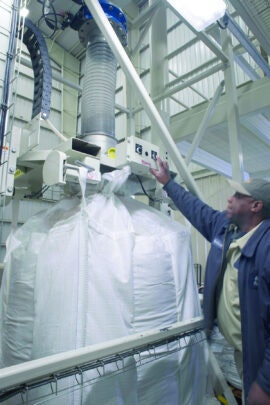
The operator only needs to pull the bag spout off the inflatable collar and tie it closed. The filled bag and pallet are removed by forklift.
“Connecting, filling and disconnecting a bag takes only about three minutes altogether,” says Oldham.
“This new facility has created over 20 permanent local jobs,” says Elton Kennedy, who along with his daughter, Meryl, oversaw design and construction of the mill. “It also gives regional producers another outlet for their rice crops with lower transportation costs and a faster return on their investment."
Inside the Mill: The Rice Polishing Process
Freshly harvested rice, known as paddy rice, is dried and shipped with hulls and bran intact to the Kennedy rice mill. This rough rice is temporarily staged in receiving tanks from which samples are taken and sent to the lab where they are graded for quality and checked for insect infestation and other contaminants. Once the rice has been catalogued by lab analysis, it is cleaned to remove insect shells, sticks, stones, mud, metals and other debris.
Milling removes the husk and bran layers, leaving the edible white rice kernel, free of impurities. “Sheller” machines first remove the hull, leaving “brown rice” in which bran layers still surround the kernel. Then milling machines rub the grains together under pressure, revealing white, or “polished,” rice, which is sorted into three different sizes.
Rice comprised of the largest kernels is called Head Rice, while rice containing the second largest kernels is called Second Head. Rice containing the smallest size kernels is called Brewers Rice because, historically, it went into brewing alcoholic beverages. After being sorted by size, the rice is then sorted by color to remove grains with insect damage, stains and other imperfections.



